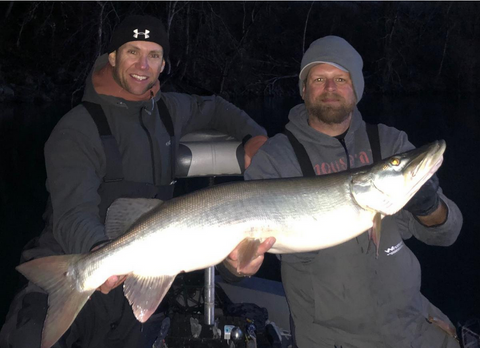Southern Musky Fishing | Cold Water Musky Tactics

As temperatures continue to cool during January and February Southern muskies make moves towards deeper structure and cover. Keep in mind the inclination to stage on deeper elements can be disrupted by dramatic fronts that will shift a forage bases preferred location. However generally speaking trophy class southern musky are haunting the deeper break-lines of our waterways.
Deep is a relative term as some southern musky waters may max out at a mere 10 feet and others present anglers with a bottomless abyss. Having an understanding of where the deep holes, pockets and pools are located on any given body of water and how they relate to their surrounding structure is imperative. Map study and comprehension may be the single most important factor in contacting trophy class fish during the winter months. Finding deep holding areas that are tantalizingly close to shallow shelfs and other complex structural elements in any body of water is the first mission of any winter muskie angler.

The tendency for late season southern muskies is to hold in these deeper areas during the majority of the day while making periodic movements to a shallower structure to feed if environmental conditions allow. It should be noted that not all deep to shallow transitional areas will be productive based solely on their topography as other key elements need to be in alignment to make these areas productive.
1.Forge fish such as shad, walleye and rough fish need to be consistently making moves in and out of, or holding in these deep to shallow zones.
2.Current which is at play on the vast majority of the South's musky lakes and rivers can dictate whether the above-mentioned forge will use a particular transitional zone. Too much current and bait fish will likely seek calmer waters, where a lack of current adjacent to an area will make it a less desirable ambush or feeding zone for winter muskies.
3.Consistency is hard to come by in the south in regards to water levels but the more consistent an area is in regards to depth and temperature can dictate how productive it is throughout the winter months. Fluctuation will always take place due to seasonal rain and snow fall however if a transitional areas shallow food shelf becomes high and dry muskies holding in the adjacent deep water will often move on to greener pastures.
With these factors in mind make the most of your map study to find littoral zones leading to moderate breaks adjacent to deep holes. Points and bars that connect littoral zones to the main basin or deep holes are also a serious consideration as they can provide southern winter muskies with all the elements, they need to be efficient hunters.

Presenting to Deep Tennessee Muskies:
Barring that you are on the water under perfect conditions and encounter a shallow bite scenario the majority of your presentations need to meet the following requirement.
- The ability of achieve a deep running depth quicky
- Large vibration profile
- Hang time / Suspension / Slow Rise
With colder water temps slowing their metabolic rate southern muskies are moving slower than ever. Yes, you may on occasion encounter a musky that is “fired up” and moving like its July but this is simply not the case under most circumstances. Being prepared with the right tools that check all the above mentioned is crucial for success.
A couple presentations that hit all the right notes are:

The Titan used in conjunction with its included 28 gram deep weight makes this lure plunge deep with a very slow and tantalizing rise. This is a great presentation when muskies are on or near shallower cover, structure. The key to eliciting strikes with the Titan during winter months is being patient and not touching the reel or moving the rod for a few seconds after each pull. Let the Titan “do it’s thing” on the pause with a little bit of slack line. Moderate activity level and even negative and neutral muskies can come unglued when the Titan is hanging there rising ever so slowly.

The tendency for most late season anglers is to go for the heaviest rubber lures they can find. While this is productive when southern muskies are moving and active, it can be the kiss of death when things are “not so hot”. The mid weighting of this lure allows anglers to capitalize on the hang time after each rip of this lure. After each hard pull / sweep of the lure allow some time for the Medusa to hang and them fall at a slow rate. A small amount of slack line will provide the Medusa the chance to fall at different angles which is often the key to generating a strike

The Viper admittedly is a shallow running bait in most regards but when used by a patient angler it is a deadly Winter presentation. The Viper has a pretty consistent sink rate of 1 foot per second when it is in free fall. With this sink rate in mind, it can be effectively used to contour deeper cover and structure. The Viper has a glide bait side to side walk the dog action but is unique in the regard that this action is achieved by turning the reel handle. The simplicity of turning the handle and getting a great action means you know this lure is walking side to side deep subsurface allowing you to count it down and contour your target area. This presentation style can be achieved with traditional gliders but is far easier and effective with the Viper.
Southern winter musky fishing takes a little homework and some dialed in presentations but the rewards can be huge. Attention should be paid to solar lunar charts when conditions are stable as bite windows often happen during majors this time of year.
Cheers,
